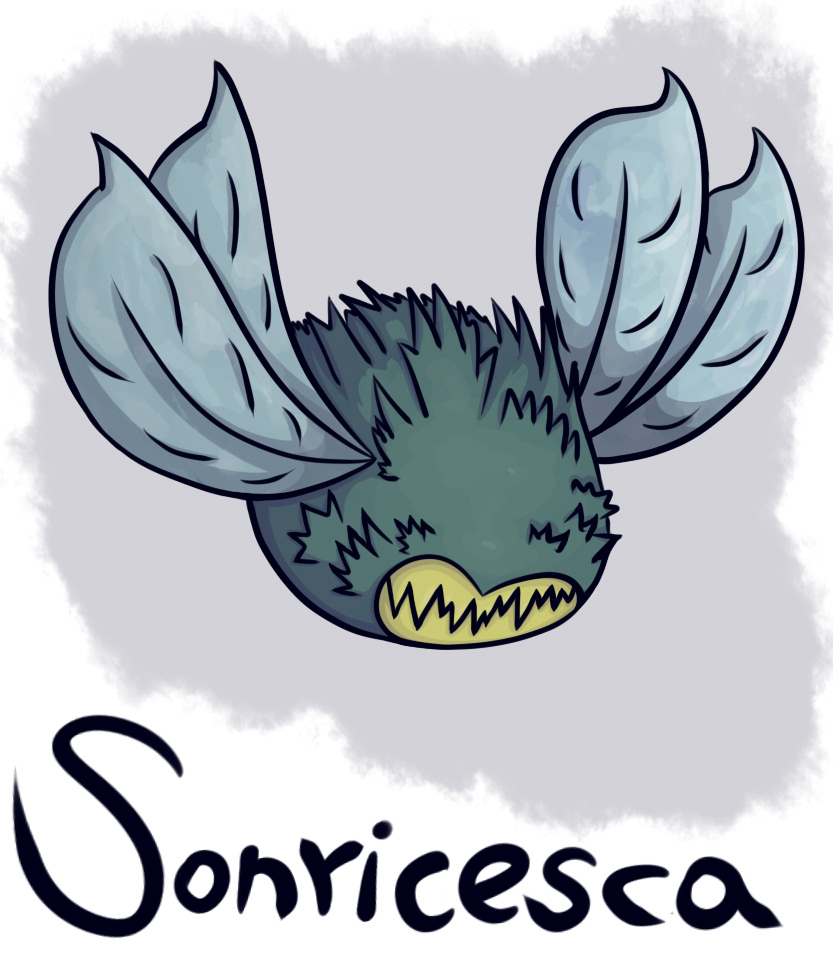Sonricesca
Sonricescas Natura Mutibugs Aero, they are a variant of the Sonroscas that originated when some Sonroscas ventured into the cold regions of Borelis.
While they share the general shape of a regular Sonroscas, Sonricescas exhibit clear differences: sharper yellow teeth, longer wings with a different shape and color, and an additional pair of wings positioned above the regular ones. Notably, they are covered in messy and pointy blue fur.
The migration of Sonroscas to Borelis occurred on charging boats loaded with food, which attracted Sonroscas and make them hide in them, they consumed the food charging during the journey. When the food supplies were depleted in Borelis the Sonroscas also came along side with it, now in Borelis with no way of going back the Sonroscas had to adapted to the harsh cold environment of the region.
Their teeth evolved to become sharper, allowing them to bite and crack hard frozen food. In groups, they use their teeth like pickaxes to break the food into smaller, more manageable chunks.
To withstand the cold, Sonricescas developed fur for insulation. The fur took on a blue hue for camouflage in the snowy surroundings. The increased fur coverage added weight, prompting the development of a second pair of wings to effectively carry their heavier bodies, all of these changes took place over a long period of time.
They fly roughly at the same speed and way as normal Sonroscas, although their movements are more clunky and paused.
Sonricescas still share many characteristics with Sonroscas, including a robust jaw with flexible cheeks that can expand. They maintain a broad diet, capable of consuming almost any organic matter. They are social creatures that travel in swarms and can join forces with other swarms when they meet. Communication among Sonricescas primarily occurs through the clashing of their teeth, albeit in a more limited manner than regular Sonroscas.
Unlike regular Sonroscas, Sonricescas lay their eggs externally, placing them in nests created in warm locations inside trees or beneath structures. When a Sonricesca is approaching natural death, it tends to move towards its eggs and passes away alongside them. This results in the Sonricesca's body forming a protective cover over the eggs, creating a large blanket when combined with other Sonricescas who followed the same pattern.
Newborn Sonricescas lack wings and spend their early days rolling around in the nest, consuming the eggs they hatched from and the decomposing bodies of Sonricescas from the blanket that can no longer retain heat. Adult Sonricescas provide food to the offspring until they develop wings and mature.
Unlike with normal Sonroscas, Blomblys don't spawn in swarms of Sonricescas, and the reason for this is unknown. In fact, Sonricescas have completely forgoten about the relation they used to haved with Blomblys, to the extent that they may even attack them if encountered.
During the night, Sonricescas gather together in their nests, forming a clump with the live mature individuals on the outer layer. Beneath them is a layer of deceased Sonricescas, followed by the newborns and, at the core, the eggs.
Sonricescas search for food by following scents. They have also learned to track other species to consume their leftovers and feces left behind.
Over time, some Sonricescas ventured out of Borelis via charging boats again and settled back in the cold regions of the Prime Continent previously untouched by normal Sonroscas.

Branch: Natura
Category: Mutibugs
Subcategory: Aero
Etymology: "Sonrisa" (Smile) + Ice + "Mosca" (Fly)
Sex Ratio: 50% Male/50% Female
Sapience: ---